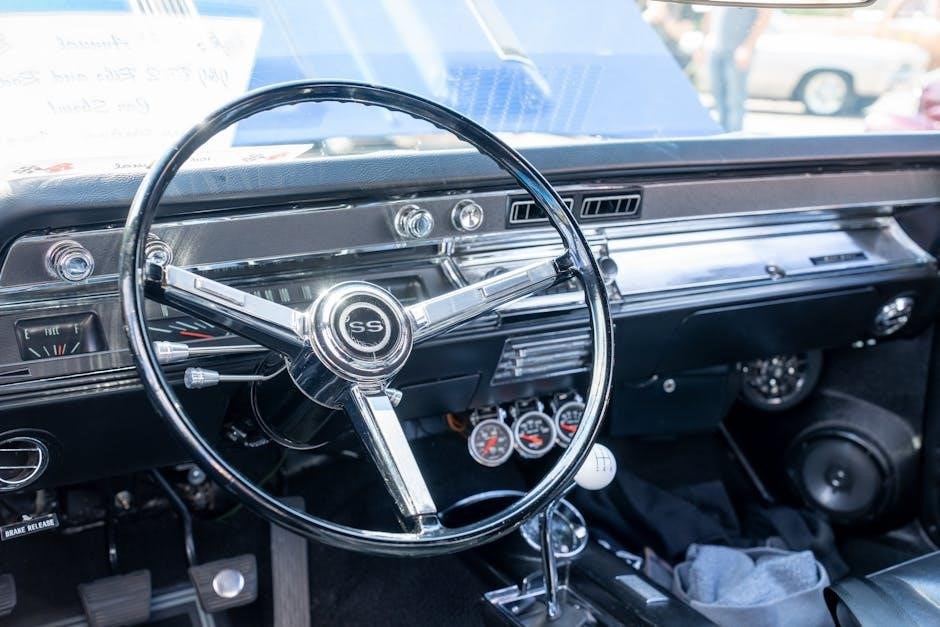The Montana CDL Manual is a comprehensive guide updated in 2023‚ detailing regulations‚ licensing requirements‚ and safe driving practices for commercial drivers in Montana. It is essential for understanding the state-specific rules and preparing for the CDL test‚ covering topics such as vehicle inspection‚ endorsements‚ and medical certifications. The manual is available online or at local County Driver License offices‚ serving as a key resource for aspiring and current commercial drivers.
1.1 Purpose and Importance of the Manual
The Montana CDL Manual serves as a vital resource for commercial drivers‚ providing detailed guidance on licensing requirements‚ safety protocols‚ and testing procedures. Its purpose is to ensure drivers understand state and federal regulations‚ preparing them for the CDL exam and safe operation of commercial vehicles. The manual is essential for both aspiring and current drivers‚ offering clear instructions on endorsements‚ restrictions‚ and medical certifications. It emphasizes road safety and compliance‚ making it indispensable for anyone seeking to obtain or maintain a Montana CDL.
1.2 Latest Updates and Revisions (2023)
The Montana CDL Manual was updated in 2023 to reflect current federal and state regulations. Revisions include changes to Hours of Service (HOS) rules‚ updated medical certification requirements‚ and new guidelines for electronic logging devices (ELDs). Additionally‚ the manual now incorporates enhanced safety protocols for hazardous materials transportation and clarifies endorsements for specific vehicle types. These updates ensure compliance with federal standards and provide drivers with the most accurate information to maintain safety and operational efficiency on Montana roads.
1.3 Where to Access the Montana CDL Manual
The Montana CDL Manual is readily available online through the official Montana Department of Justice website. Drivers can download a free PDF version‚ ensuring easy access to the latest information. Additionally‚ hard copies can be obtained by visiting local Motor Vehicle Division (MVD) offices across the state. The manual is also searchable and bookmarkable‚ making it user-friendly for study purposes. This accessibility ensures all applicants have the resources needed to prepare for their CDL tests effectively.

Commercial Driver License (CDL) Overview
A CDL is required for operating vehicles over 26‚001 lbs or designed to transport 16+ passengers. It ensures drivers meet safety and skill standards.
2.1 What is a CDL?
A Commercial Driver License (CDL) is a professional license required to operate heavy vehicles weighing over 26‚001 lbs or designed to transport 16 or more passengers. Issued by the state‚ it ensures drivers meet specific safety and skill standards. A CDL is essential for operating vehicles like semi-trucks‚ buses‚ and hazardous material carriers. It verifies that a driver has the knowledge and skills to handle large vehicles safely and responsibly on public roads.
2.2 Types of CDLs (Class A‚ B‚ and C)
A CDL is categorized into three classes: A‚ B‚ and C. Class A allows operation of combination vehicles with a trailer weighing over 10‚001 lbs. Class B covers heavy straight trucks and vehicles with a trailer weighing less than 10‚001 lbs. Class C is for small passenger vehicles or hazardous material carriers requiring a CDL but not meeting Class A or B criteria. Each class reflects the type and weight of vehicles a driver is authorized to operate‚ ensuring proper licensing for specific roles.
2.3 CDL Endorsements and Restrictions
CDL endorsements and restrictions modify a driver’s authorization based on their qualifications and vehicle type. Endorsements‚ such as H (hazardous materials) or N (tank vehicles)‚ require additional testing. Restrictions‚ like E (no manual transmission) or L (no air brakes)‚ limit driving privileges. These designations ensure drivers operate only vehicles they are trained and tested for‚ enhancing safety and compliance with federal and state regulations. Proper endorsements and lack of restrictions are critical for legal and safe commercial driving in Montana.

Licensing Requirements and Eligibility
Montana CDL applicants must meet specific criteria‚ including age‚ residency‚ and medical standards. Requirements include a valid ID‚ background checks‚ and passing necessary tests. Additional documentation and fees apply.
3.1 Age Requirements for CDL Applicants
In Montana‚ CDL applicants must be at least 18 years old for intrastate driving and 21 years old for interstate commerce. Federal regulations apply‚ requiring drivers to be 21+ for interstate operations. Proof of age is mandatory during the application process‚ and applicants must meet all federal and state age requirements to qualify for a commercial driver’s license. Additional documentation‚ such as a birth certificate or valid ID‚ may be required to verify eligibility. These age requirements ensure compliance with safety standards and legal driving regulations.
3.2 Medical Certification and DOT Physical
In Montana‚ CDL applicants must pass a Department of Transportation (DOT) physical exam to ensure they meet federal health standards. The exam must be conducted by an FMCSA-certified medical examiner. A valid medical certificate is required to apply for or renew a CDL. The certification is typically valid for 2 years‚ but this may vary depending on individual health conditions. Drivers must maintain a current medical card and provide updates to the state. Failure to comply can result in CDL suspension or downgrade.
3.3 Fees Associated with CDL Licensing
Fees for obtaining a Montana CDL vary based on the license type and endorsements. The base fee for a Class A‚ B‚ or C CDL is typically around $50-$60 for a 5-year license. Additional fees apply for endorsements‚ such as Hazmat ($10-$30) or Tank Vehicles ($10). Skills test fees range from $50 to $150‚ depending on the testing location. Applicants should also budget for the DOT physical exam (around $100) and any required medical certifications. Fees are subject to change‚ so applicants should verify current costs with the Montana MVD.
3.4 CDL Exemptions and Exceptions
Certain drivers and vehicles are exempt from requiring a CDL in Montana. Farmers operating agricultural vehicles within 150 miles of their farm are exempt. Firefighters and emergency responders driving fire trucks or emergency vehicles for non-commercial purposes are also exempt. Military members operating military vehicles are not required to hold a CDL. Additionally‚ drivers of vehicles with a gross vehicle weight rating (GVWR) of 10‚001 pounds or less may not need a CDL‚ depending on the vehicle type and use. Always consult the Montana MVD for specific exemptions.

CDL Application and Testing Process
Submit a completed CDL application to the Montana MVD‚ provide required documentation‚ and pass written knowledge tests. Schedule and pass a skills test to obtain your CDL;
4.1 Steps to Apply for a Montana CDL
To apply for a Montana CDL‚ complete an application at your local MVD office. Submit proof of identity‚ residency‚ and Social Security number. Obtain a Commercial Learner’s Permit (CLP) by passing required knowledge tests. Schedule a skills test with an approved examiner. Pass the pre-trip inspection‚ basic vehicle control‚ and road test to obtain your CDL. Ensure all fees are paid‚ and meet medical certification requirements. Follow MVD guidelines for processing and issuance.
4.2 Required Documentation for CDL Application
To apply for a Montana CDL‚ you must provide specific documents. These include proof of identity‚ such as a valid passport or birth certificate‚ and two proofs of residency‚ like utility bills or a lease agreement. You’ll also need your Social Security card or equivalent. Additionally‚ submit a completed Medical Examiner’s Certificate and maintain a valid Commercial Learner’s Permit (CLP). Ensure all documents are up-to-date and meet MVD requirements. Any additional documentation should be verified with the Montana Department of Justice MVD.
4.3 Written Knowledge Tests
The written knowledge tests are a critical part of the CDL application process. Applicants must pass a General Knowledge Test covering traffic laws‚ safe driving practices‚ and vehicle inspection. Additional tests are required for specific endorsements‚ such as air brakes or hazardous materials. The tests are typically multiple-choice and based on the Montana CDL Manual. A passing score is 80%‚ and applicants with endorsements may need to take multiple exams. These tests ensure drivers have the necessary knowledge to operate commercial vehicles safely and legally.
4.4 Skills Test (Pre-Trip Inspection‚ Basic Vehicle Control‚ and Road Test)
The skills test evaluates practical abilities essential for safe commercial driving. It includes a pre-trip inspection to identify vehicle defects‚ basic vehicle control exercises like backing and maneuvering‚ and a road test assessing driving skills in real traffic. Applicants must demonstrate proficiency in all areas to pass. The test ensures drivers can operate safely and handle various driving scenarios effectively‚ aligning with federal and state CDL standards.

CDL Knowledge and Skills Testing
This section covers the tests required to obtain a CDL‚ including knowledge exams and practical skills assessments. It ensures applicants have the necessary expertise to operate safely.
5.1 General Knowledge Test
The General Knowledge Test is the foundation of the CDL testing process‚ covering essential topics like traffic laws‚ road signs‚ safe driving practices‚ and vehicle inspection procedures. It assesses a driver’s understanding of cargo management‚ emergency procedures‚ and federal regulations. The test is mandatory for all CDL applicants and serves as a baseline for further specialized testing; Proper preparation using the Montana CDL Manual and practice tests is crucial for success. This test ensures applicants possess the fundamental knowledge needed to operate a commercial vehicle safely and legally.
5.2 Combination Vehicles Test
The Combination Vehicles Test focuses on the safe operation of vehicles towing one or more trailers. It covers topics like coupling and uncoupling‚ trailer braking systems‚ and handling longer vehicles. Applicants learn about weight distribution‚ towing limits‚ and the unique challenges of managing combination vehicles. The test includes questions on safety procedures‚ such as checking trailer connections and understanding cargo balance. Proper preparation using the Montana CDL Manual and practice tests is essential to master this specialized knowledge‚ ensuring safe and efficient operation of combination vehicles on the road.
5.3 Air Brakes Test
The Air Brakes Test evaluates a driver’s understanding of air brake systems‚ a critical component of large commercial vehicles. Topics include the operation of air brake components‚ safety inspections‚ and proper usage techniques. Applicants must demonstrate knowledge of air pressure gauges‚ brake chambers‚ and emergency brake procedures. Understanding how to conduct pre-trip inspections and handle air brake failures is essential. The Montana CDL Manual provides detailed information to help candidates prepare for this specialized test‚ ensuring they can safely operate vehicles equipped with air brakes.
5.4 Tank Vehicles Test
The Tank Vehicles Test focuses on the unique challenges of operating tank vehicles‚ which carry liquids or gases. This test assesses knowledge of loading and unloading procedures‚ cargo securement‚ and weight distribution to prevent rollovers. Drivers must understand how to handle the dynamic movement of liquid cargo and follow safety protocols for hazardous materials. The Montana CDL Manual provides detailed guidance on these topics to help applicants prepare for the test and ensure safe operation of tank vehicles on the road.
5.5 Hazmat Test
The Hazmat Test is required for drivers transporting hazardous materials. It covers safety protocols‚ emergency procedures‚ and regulatory requirements. Topics include identifying hazmat classes‚ proper handling techniques‚ and compliance with federal and state laws. The test emphasizes the importance of securement‚ placarding‚ and documentation. Drivers must demonstrate knowledge of spill response and communication with authorities. Preparation involves studying the Montana CDL Manual’s hazmat section thoroughly to ensure safe and legal transport of hazardous materials‚ protecting both the driver and the public.
5.6 Doubles and Triples Test
The Doubles and Triples Test is an optional endorsement for drivers operating double or triple trailer combinations. It assesses knowledge of safe coupling and uncoupling procedures‚ weight distribution‚ and handling longer vehicles. Topics include turning techniques‚ braking strategies‚ and managing trailer dynamics. The test also covers emergency procedures and regulatory requirements for operating multi-trailer setups. Understanding load distribution and trailer stability is crucial for safe operation. This endorsement ensures drivers can handle the unique challenges of double and triple trailer configurations effectively.
5.7 Passenger Vehicle Test
The Passenger Vehicle Test is required for drivers seeking a Passenger endorsement (P) to operate buses and other vehicles designed to transport 16 or more passengers. The test focuses on safety practices‚ passenger management‚ and emergency procedures. Topics include loading/unloading passengers‚ emergency exits‚ and handling unique vehicle dynamics. Understanding federal and state regulations for passenger vehicles is essential. The test ensures drivers can safely operate and manage passenger vehicles‚ adhering to specific safety and operational standards. Proper preparation is key to passing this specialized endorsement test.
5.8 School Bus Test
The School Bus Test is required for drivers seeking the School Bus (S) endorsement‚ allowing them to transport students. The test covers unique safety protocols‚ student management‚ and emergency procedures. Topics include loading/unloading children‚ emergency evacuations‚ and operating specific safety devices. Drivers must demonstrate knowledge of school bus regulations and safe driving practices. Passing this test ensures they can safely transport children‚ adhering to strict safety standards. Thorough preparation using the Montana CDL Manual and practice tests is crucial for success.

Vehicle Inspection and Safety
Vehicle inspection and safety are critical for ensuring safe operations. This section covers pre-trip‚ en-route‚ and post-trip inspections‚ as well as maintenance and compliance with regulations.
6.1 Pre-Trip Inspection Requirements
The pre-trip inspection ensures the vehicle is safe to operate. Drivers must check the driver’s side‚ engine‚ brakes‚ tires‚ lights‚ mirrors‚ cargo‚ and trailer connections. This step helps prevent mechanical issues and ensures compliance with safety standards. Regular inspections reduce risks and promote road safety. Montana CDL holders are required to follow these procedures diligently before starting their journey.
6.2 En-Route Inspection and Safety Checks
During transit‚ drivers must monitor the vehicle’s condition and surroundings. This includes checking brakes‚ tires‚ and lights for malfunction. Adjust speed according to road conditions and weather. Ensure cargo remains secure to prevent shifting. Regularly inspect mirrors and maintain situational awareness. Report any issues promptly to avoid hazards. En-route checks are critical for maintaining safety and preventing potential accidents or breakdowns. Stay alert and follow traffic laws to ensure a smooth journey.
6.3 Post-Trip Inspection Procedures
After reaching the destination‚ drivers must conduct a thorough post-trip inspection. Check for damage‚ leaks‚ or wear on tires‚ brakes‚ and suspension. Ensure all lights‚ signals‚ and reflective devices are functioning. Inspect cargo securement and verify the vehicle’s systems‚ such as air brakes and hydraulics. Document any issues or needed repairs. This step ensures safety and compliance with regulations‚ helping to prevent future mechanical failures. Regular post-trip checks also promote vehicle longevity and operational efficiency.

Safe Driving Practices
Safe driving practices include maintaining a safe distance‚ using mirrors‚ following speed limits‚ and being cautious with oversized vehicles‚ especially in adverse weather.
7.1 Sharing the Road with Other Drivers
Sharing the road with other drivers requires courtesy‚ awareness‚ and patience. Always be mindful of other vehicles‚ including passenger cars‚ motorcycles‚ and pedestrians. Use mirrors and check blind spots frequently to stay informed. Maintain a safe following distance and avoid aggressive maneuvers. Be cautious when passing or changing lanes‚ ensuring plenty of space. Respect the space of larger vehicles‚ as they may have limited visibility or stopping ability. Yield the right of way when necessary and avoid distractions to promote a safe driving environment for everyone.
7.2 Handling Emergency Situations
Handling emergency situations requires calm and quick decision-making. Stay alert and prepared for unexpected events like vehicle breakdowns or medical emergencies. In case of a breakdown‚ move to a safe location and use reflective triangles or flares. For medical emergencies‚ assess injuries and provide basic first aid if trained. Keep an emergency kit in the vehicle. In case of a fire‚ evacuate immediately and use a fire extinguisher if safe. Always prioritize safety and communicate with authorities as needed. Stay composed to minimize risks and protect yourself and others.
7.3 Night Driving and Extreme Weather Conditions
Night driving and extreme weather require heightened vigilance. Reduce speed and increase following distance to compensate for reduced visibility. Use high beams cautiously to avoid blinding others. In fog‚ slow down and use low beams. For snow or ice‚ reduce speed and avoid sudden movements. In heavy rain‚ maintain a safe distance and avoid hydroplaning. Be prepared for crosswinds when driving large vehicles. Always keep emergency supplies accessible. If conditions become too hazardous‚ pull over safely and wait for improvement. Stay alert and adapt driving habits to match the environment.

Federal and State Regulations
Federal and state regulations ensure safety and compliance for commercial drivers. The FMCSA sets national standards‚ while Montana tailors rules to local needs. Adherence is mandatory.
8.1 Hours of Service (HOS) Regulations
Hours of Service (HOS) regulations dictate the maximum time commercial drivers can operate a vehicle. Montana follows federal rules‚ limiting driving to 11 hours after 10 consecutive hours off-duty. A 30-minute break is required after 8 hours of driving. The 14-hour on-duty window includes all work activities‚ and drivers must maintain a log‚ either manually or via electronic logging devices (ELDs). These rules aim to prevent fatigue and ensure road safety for both drivers and the public.
8.2 Drug and Alcohol Testing Policies
Montana adheres to federal drug and alcohol testing policies for CDL holders. Drivers are subject to testing before employment‚ randomly‚ after accidents‚ and upon reasonable suspicion. Tests detect marijuana‚ cocaine‚ amphetamines‚ opiates‚ and alcohol. A blood alcohol concentration (BAC) of 0.04% or higher results in disqualification. Violations lead to mandatory substance abuse counseling and license suspension. These regulations ensure public safety by preventing impaired driving and promoting a drug-free workforce among commercial drivers.
8.3 CDL Disqualifications and Penalties
A CDL can be disqualified for serious offenses‚ including reckless driving‚ DUI‚ or accidents involving fatalities. Major violations‚ such as using a commercial vehicle in a felony‚ result in lifetime disqualification. Penalties vary by offense severity‚ with temporary suspensions or permanent revocation. Drivers receive notification and may appeal. Repeat offenses intensify consequences. These penalties ensure public safety by enforcing strict standards for commercial drivers.

Preparing for the CDL Test
Effective preparation involves studying the Montana CDL Manual‚ completing practice tests‚ and mastering driving skills. Utilize online resources and professional guidance to ensure readiness.
9.1 Study Resources and Materials
The Montana CDL Manual is the primary resource for test preparation‚ covering all necessary topics and regulations. Additional study materials include online practice tests‚ CDL handbooks‚ and flashcards. Many applicants benefit from structured study guides that break down complex information into manageable sections. Utilizing official Montana Department of Transportation (DOT) resources ensures accuracy and relevance. Online forums and driver training courses also provide valuable insights and tips. A well-organized study plan‚ combined with these resources‚ enhances understanding and retention of critical information for the CDL exam.
9.2 Practice Tests and Study Guides
Practice tests and study guides are essential tools for CDL exam preparation. Official Montana CDL practice tests simulate real exam conditions‚ helping applicants assess their readiness. Study guides provide detailed explanations of complex topics‚ ensuring a thorough understanding. Popular resources include online platforms offering CDL-specific practice questions and mobile apps designed for on-the-go studying. These tools help identify weak areas‚ allowing focused revision. Regular use of practice tests and guides significantly improves knowledge retention and exam performance‚ ensuring applicants are well-prepared for the Montana CDL test.
9.3 Tips for Effective Test Preparation
Effective test preparation involves creating a structured study schedule‚ focusing on weak areas‚ and practicing consistently. Utilize active learning techniques like flashcards or explaining concepts aloud. Simulate test conditions by timing yourself and avoiding distractions. Review mistakes to understand and correct them. Stay well-rested‚ hydrated‚ and mentally calm before the exam. Additionally‚ seek guidance from instructors or experienced drivers to gain insights and confidence. A disciplined and organized approach ensures readiness and boosts performance on the Montana CDL test.

Glossary of Terms
CDL: Commercial Driver License.
DOT: Department of Transportation.
GVWR: Gross Vehicle Weight Rating.
Endorsements: Special permits for specific cargo or vehicles.
10.1 Key Terms and Definitions
CDL: Commercial Driver License.
GVWR: Gross Vehicle Weight Rating.
DOT: Department of Transportation.
Endorsements: Special permits for specific cargo or vehicles.
Restrictions: Limits on CDL privileges.
HOS: Hours of Service regulations.
Pre-Trip Inspection: Safety check before driving.
Air Brakes: Brake system using compressed air.
Tanker Endorsement: Required for liquid cargo.
Hazmat: Hazardous materials endorsement.
Disqualification: Loss of CDL privileges due to violations.
Obtaining a Montana CDL requires dedication and understanding of regulations. Stay committed to safe driving practices and continuous learning for a successful career in commercial driving.
11.1 Final Tips for Success
To excel as a commercial driver in Montana‚ stay updated on regulations and best practices. Regularly review the CDL manual and seek feedback from instructors. Practice defensive driving and maintain a clean driving record. Stay physically and mentally fit to handle the demands of the job. Continuously improve your skills through training and experience. Remember‚ safety and professionalism are key to a successful career in commercial driving.

Leave a Reply
You must be logged in to post a comment.